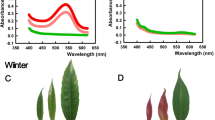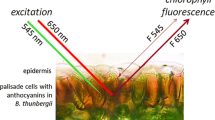Abstract
Photosynthetic organs are often characterized by anthocyanins being accumulated either in the epidermal or in the mesophyll cells making these tissues to turn reddish-brown in colour. It has been hypothesized that these pigments protect underlying chloroplasts from light-stress because they absorb photons of the photosynthetically active waveband. However, the photoprotective role of anthocyanins has not been undoubtedly shown on a broad range of species. In this study, green and anthocyanic areas of leaves of Pelargonium × hortorum, the latter possessing variable levels of anthocyanins, were compared using pigment analysis and pulse amplitude modulated in vivo chlorophyll (Chl) fluorescence. Quenching analysis of the induction and dark relaxation curves of slow Chl fluorescence kinetics showed that at photoinhibitory conditions [by applying above-saturation light intensity of 1,600 μmol(quantum) m−2 s−1 white light at low (4°C) temperature], anthocyanic areas were at least equally sensitive to photoinhibition as green leaf areas. In fact, the level of photoinhibition tended to be proportional to the level of anthocyanin accumulation suggesting that this characteristic was indicative of the photoinhibitory risk. The results of the present study clearly show that anthocyanins in leaf areas of Pelargonium do not afford a photoprotective advantage.
Similar content being viewed by others
Abbreviations
- ANOVA :
-
analysis of variance
- Car (x+c):
-
total carotenoids
- Chl(s):
-
chlorophyll(s)
- F:
-
chlorophyll fluorescence yield
- Fo :
-
minimal fluorescence at the dark-adapted state
- Fo′:
-
minimal fluorescence at the light-adapted state
- Fm :
-
maximal fluorescence at the dark-adapted state
- Fm′:
-
maximal fluorescence at the light-adapted state
- Fm″:
-
maximal fluorescence during the dark relaxation phase
- FR:
-
far-red
- Fs :
-
steady-state level fluorescence
- Fv :
-
variable fluorescence at the dark-adapted state
- NPQ:
-
nonphotochemical quenching
- PAM:
-
pulse amplitude modulated
- PAR:
-
photosynthetically active radiation
- PFD:
-
photon flux density
- PSII:
-
photosystem II
- qE :
-
energy-dependent fluorescence quenching component
- qI :
-
photoinhibitory fluorescence quenching component
- qN :
-
nonphotochemical fluorescence quenching coefficient
- qP :
-
photochemical fluorescence quenching coefficient
- qT :
-
transition state fluorescence quenching component
- ΦPSII = ΔF/Fm′:
-
effective quantum yield of PSII photochemistry
- ΦPSIIo = Fv/Fm :
-
maximum (intrinsic) quantum yield of PSII photochemistry
References
Adams, W.W., III, Demmig-Adams, B.: The xanthophyll cycle and sustained thermal energy dissipation activity in Vinca minor and Euonymus kiautschovicus in winter. — Plant Cell Environ. 18: 117–127, 1995.
Anderson, J.M.: Photoregulation of the composition, function, and structure of thylakoid membranes. — Ann. Rev. Plant Physiol. 37: 93–136, 1986.
Baker, N.R.: Chlorophyll fluorescence: a probe of photosynthesis in vivo. — Ann. Rev. Plant Biol. 59: 89–113, 2008.
Burger, J., Edwards, G.E.: Photosynthetic efficiency, and photodamage by UV and visible radiation, in red versus green leaf coleus varieties. — Plant Cell Physiol. 37: 395–399, 1996.
Dodd, I.C., Critchley, C., Woodall, G.S., Stewart, G.R.: Photoinhibition in differently coloured juvenile leaves of Syzygium species. — J. Exp. Bot. 49: 1437–1445, 1998.
Döring, T.F., Archetti, M., Hardie, J.: Autumn leaves seen through herbivore eyes. — Proc. R. Soc. B 276: 121–127, 2009.
Esteban, R., Fernández-Marín, B., Becerril, J.M., García-Plazaola, J.I.: Photoprotective implications of leaf variegation in E. dens-canis L. and P. officinalis L. — J. Plant Physiol. 165: 1255–1263, 2008.
Genty, B., Brintais, J.-M., Baker, N.R.: The relationship between the quantum yield of photosyntetic electron transport and quenching of chlorophyll fluorescence. — Biochim. Biophys. Acta 990: 87–92, 1989.
Gould, K.S., Dudle, D.A., Neufeld, H.S.: Why some stems are red: cauline anthocyanins shield photosystem II against high light stress. — J. Exp. Bot. 61: 2707–2717, 2010.
Gould, K.S., Neill, S.O., Vogelmann, T.C.: A unified explanation for anthocyanins in leaves? — Adv. Bot. Res. 37: 167–192, 2002a.
Gould, K.S., McKelvie, J., Markham, K.R.: Do anthocyanins function as antioxidants in leaves? Imaging of H2O2 in red and green leaves after mechanical injury. — Plant Cell Environ. 25: 1261–1269, 2002b.
Hughes, N.M., Smith, W.K.: Attenuation of incident light in Galax urceolata (Diapensiaceae): concerted influence of adaxial and abaxial anthocyanic layers on photoprotection. — Am. J. Bot. 94: 784–790, 2007.
Jadrná, P., Plavcová, O., Kobza, F.: Morphological changes in colchicine-treated Pelargonium × hortorum L.H. Bailey greenhouse plants. — Hortic. Sci. 37: 27–33, 2010.
Krause, G.H., Weis, E.: Chlorophyll fluorescence and photosynthesis: the basics. — Ann. Rev. Plant Physiol. Plant Mol. Biol. 42: 313–349, 1991.
Kyparissis, A., Grammatikopoulos, G., Manetas, Y.: Leaf morphological and physiological adjustments to the spectrally selective shade imposed by anthocyanins in Prunus cerasifera. — Tree Physiol. 27: 849–857, 2007.
Kytridis, V.-P., Karageorgou, P., Levizou, E., Manetas, Y.: Intra-species variation in transient accumulation of leaf anthocyanins in Cistus creticus during winter: Evidence that anthocyanins may compensate for an inherent photosynthetic and photoprotective inferiority of the red-leaf phenotype. — J. Plant Physiol. 165: 952–959, 2008.
Kytridis, V.-P., Manetas, Y.: Mesophyll versus epidermal anthocyanins as potential in vivo antioxidants: evidence linking the putative antioxidant role to the proximity of oxy-radical source. — J. Exp. Bot. 57: 2203–2210, 2006.
Liakopoulos, G., Nikolopoulos, D., Klouvatou, A., Vekkos, K.- A., Manetas, Y., Karabourniotis, G.: The photoprotective role of epidermal anthocyanins and surface pubescence in young leaves of grapevine (Vitis vinifera). — Ann. Bot. 98: 257–265, 2006.
Lichtenthaler, H.K.: Chlorophylls and carotenoids: Pigments of photosynthetic biomembranes — Methods Enzymol.. 148: 350–382, 1987.
Logan, B.A., Adams, W.W., III, Demmig-Adams, B.: Avoiding common pitfalls of chlorophyll fluorescence analysis under field conditions. — Funct. Plant Biol. 34: 853–859, 2007.
Mancinelli, A.L., Yang, C.-P.H., Lindquist, P., Anderson, O.R., Rabino, I.: Photocontrol of anthocyanin synthesis. III. The action of streptomycin on the synthesis of chlorophyll and anthocyanin. — Plant Physiol. 55: 251–257, 1975.
Manetas, Y.: Why some leaves are anthocyanic and why most anthocyanic leaves are red? — Flora 201: 163–177, 2006.
Manetas, Y., Petropoulou, Y., Psaras, G.K., Drinia, A.: Exposed red (anthocyanic) leaves of Quercus coccifera display shade characteristics. — Funct. Plant Biol. 30: 265–270, 2003.
Matsubara, S., Krause, G.H., Aranda, J, et al.: Sun-shade patterns of leaf carotenoid composition in 86 species of neotropical forest plants. — Funct. Plant Biol. 36: 20–36, 2009.
Merzlyak, M.N., Chivkunova, O.B., Solovchenko, A.E., Razi Naqvi, K.: Light absorption by anthocyanins in juvenile, stressed, and senescing leaves. — J. Exp. Bot. 59: 3903–3911, 2008.
Neill, S., Gould, K.S.: Optical properties of leaves in relation to anthocyanin concentration and distribution. — Can. J. Bot. 77: 1777–1782, 1999.
Neill, S.O., Gould, K.S.: Anthocyanins in leaves: light attenuators or antioxidants? — Funct. Plant Biol. 30: 865–873, 2003.
Nielsen, S.L., Simonsen, A.-M.: Photosynthesis and photoinhibition in two differently coloured varieties of Oxalis triangularis — the effect of anthocyanin content. — Photosynthetica 49: 346–352, 2011.
Nikiforou, C., Manetas, Y.: Strength of winter leaf redness as an indicator of stress vulnerable individuals in Pistacia lentiscus. — Flora 205: 424–427, 2010.
Smillie, R.M., Hetherington, S.E.: Photoabatement by anthocyanin shields photosynthetic systems from light stress. — Photosynthetica 36: 451–463, 1999.
Steyn, W.J., Wand, S.J.E., Holcroft, D.M., Jacobs, G.: Anthocyanins in vegetative tissues: a proposed unified function in photoprotection. — New Phytol. 155: 349–361, 2002.
Sun, J., Nishio, J.N., Vogelmann, T.C.: Green light drives CO2 fixation deep within leaves. — Plant Cell Physiol. 39: 1020–1026, 1998.
Takahashi, S., Milward, S.E., Yamori, W., Evans, J.R., Hillier, W., Badger, M.R.: The solar action spectrum of photosystem II damage. — Plant Physiol. 153: 988–993, 2010.
Terashima, I., Fujita, T., Inoue, T., Chow, W.S., Oguchi, R.: Green light drives leaf photosynthesis more efficiently than red light in strong white light: revisiting the enigmatic question of why leaves are green. — Plant Cell Physiol. 50: 684–697, 2009.
van den Berg, A.K., Perkins, T.D.: Contribution of anthocyanins to the antioxidant capacity of juvenile and senescing sugar maple (Acer saccharum) leaves. — Funct. Plant Biol. 34: 714–719, 2007.
van den Berg, A.K., Vogelmann, T.C., Perkins, T.D.: Anthocyanin influence on light absorption within juvenile and senescing sugar maple leaves do anthocyanins function as photoprotective visible light screens? — Funct. Plant Biol. 36: 793–800, 2009.
van Kooten, O., Snel, J.F.H.: The use of chlorophyll fluorescence nomenclature in plant stress physiology. — Photosynth. Res. 25: 147–150, 1990.
van Wijk, K.J., van Hasselt, P.R.: Photoinhibition of photosystem II in vivo is preceded by down-regulation through light-induced acidification of the lumen: Consequences for the mechanism of photoinhibition in vivo. — Planta 189: 359–368, 1993.
Walters, R.G., Horton, P.: Resolution of components of nonphotochemical chlorophyll fluorescence quenching in barley leaves. — Photosynth. Res. 27: 121–133, 1991.
Zeliou, K., Manetas, Y., Petropoulou, Y.: Transient winter leaf reddening in Cistus creticus characterizes weak (stress-sensitive) individuals, yet anthocyanins cannot alleviate the adverse effects on photosynthesis. — J. Exp. Bot. 60: 3031–3042, 2009.
Zeng, X.-Q., Chow, W.S., Su, L.-J., Peng, X.-X., Peng, C.-L.: Protective effect of supplemental anthocyanins on Arabidopsis leaves under high light. — Physiol. Plant. 138: 215–225, 2010.
Zhang, K.-M., Yu, H.-J., Shi, K., Zhou, Y.-H., Yu, J.-Q., Xia, X.-J.: Photoprotective roles of anthocyanins in Begonia semperflorens. — Plant Sci. 179: 202–208, 2010.
Author information
Authors and Affiliations
Corresponding author
Additional information
Acknowledgements: The authors wish to thank Professor Yiannis Manetas (University of Patras, Greece) for useful discussion concerning the manuscript.
Rights and permissions
About this article
Cite this article
Liakopoulos, G., Spanorigas, I. Foliar anthocyanins in Pelargonium × hortorum are unable to alleviate light stress under photoinhibitory conditions. Photosynthetica 50, 254–262 (2012). https://doi.org/10.1007/s11099-012-0031-9
Received:
Accepted:
Published:
Issue Date:
DOI: https://doi.org/10.1007/s11099-012-0031-9




